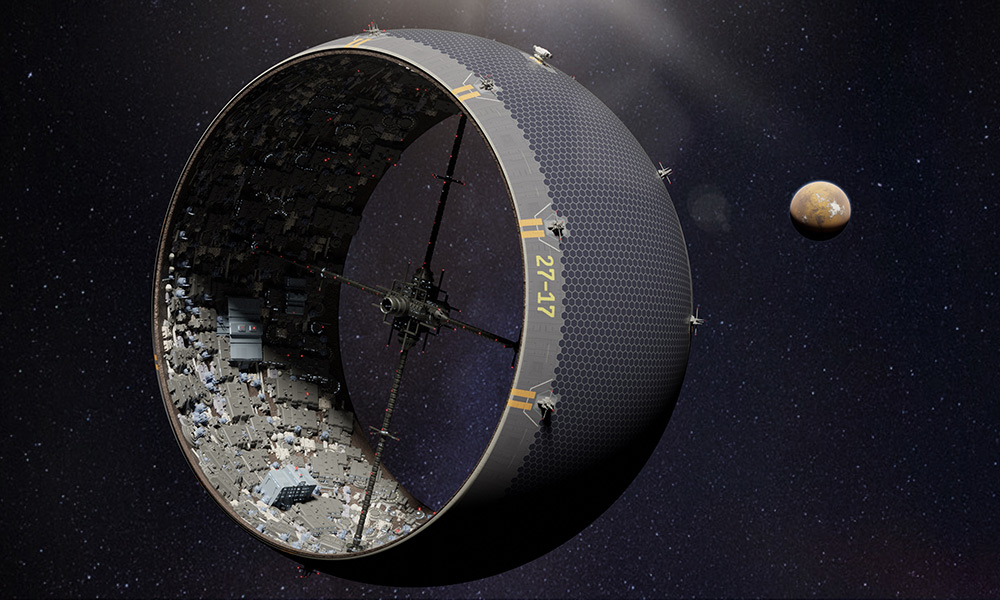
Physicists from the University of Rochester set themselves the task of developing a practical method of creating a space in space in which people could live peacefully without the costly launch of the necessary materials from Earth. A paper in the journal Frontiers in Astronomy and Space Sciences, which the researchers called “wildly theoretical,” explores a sci-fi idea similar to that depicted in Amazon’s The Expanse series — using an asteroid to build a city.
A rotating space metropolis
In 1972, NASA commissioned the physicist Gerard O’Neill to design a space environment for human life – this is how the so-called “O’Neill Colony” appeared. The space metropolis, according to the concept, was supposed to consist of two cylinders rotating in opposite directions, with a rod connecting them at the ends. They rotate at a speed sufficient to create artificial gravity and comfortable for people to stay there.
Since then, films (including Star Trek) and books (such as Orson Scott Card’s 1985 novel Ender’s Game) have depicted O’Neill’s cylindrical environments populated by humans. Jeff Bezos referred to the concept in his visions of the future space in space, and Elon Musk called it “preposterous”.
Although O’Neill cylinders offer a solution to the problem of the absence of gravity in space, transporting the necessary building materials from Earth to space to create them would be a difficult and prohibitively expensive task.
A flying mountain of material
Asteroids are solid bodies that orbit the Sun and are left over from the formation of the Solar System about 4.6 billion years ago. According to scientists, about 1,000 asteroids with a diameter of more than a kilometer travel in our solar system.
The team from Rochester believes that asteroids are “flying mountains with a large pile of material that could provide a faster, cheaper and more efficient way to build space cities”. And they offer a way to use it.
The problem is that asteroids aren’t big enough to provide the necessary gravity (long periods in zero or low gravity cause a number of health problems for astronauts), so the team chose a minimum of 0.3g, which is about a third less , than during life, for example on Mars.
To provide gravity, physicists propose to “crack up” a large asteroid, spin it (using centrifugal force to create 0.3 g) and build a city hidden by a layer of rocks from cosmic radiation.
This method could work if the asteroid consisted of solid, durable rock. But most of them are not like that – physicists have studied the composition of some of the closest to us and found that they are mostly giant piles of debris from large and small stones, weakly held together by their own gravity (punch a hole in one of them, spin and “city” , which you are trying to create will simply fly off into space and disappear).
Bag made of nanofiber
In this case, scientists believe, a “protective bag” can help – a cylindrical bag, slightly larger than the asteroid itself, made of flexible, ultra-light and ultra-strong carbon nanofiber mesh, which would be able to contain this environment.
To simulate the process, the team chose a small Bennu-like asteroid with a radius of 300 m. It was wrapped in a bag of nanofibers of the appropriate size, but with the ability to stretch up to 3 km (it seems that the system works in harmony).
Theoretically, the process can go something like this:
- The asteroid would spin to create artificial gravity, a process that would inevitably lead to its disintegration;
- Asteroid fragments fly apart and expand the nanofiber bag to the maximum allowable size;
- The nanofiber is stretched, capturing debris;
- The stones later form a fairly thick layer (about 2 meters) — enough to protect everyone who lives inside from radiation. The rotation of the cylinder causes artificial gravity on the inner surface.

“Based on our calculations, an asteroid with a diameter of 300 meters, an area of only a few football fields, can be expanded into a cylindrical space medium with an area of about 56.9 square meters. km That’s about the size of Manhattan,’ the scientists say.
Even if you take an asteroid with a radius of 500 meters and spin it up, it won’t take too long to get an artificial gravity of 1 g, equivalent to Earth.
“Obviously, no one will be building asteroid cities anytime soon, but the technology required to create this kind of engineering does not violate any laws of physics. The idea may seem far-fetched until you realize that in 1900 no one had ever flown in an airplane, but right now thousands of people are sitting comfortably in their seats and hurtling at hundreds of kilometers per hour above the ground. Now space cities may seem like a fantasy, but history shows that about a century of technological progress can make the impossible possible,’ the researchers conclude.

